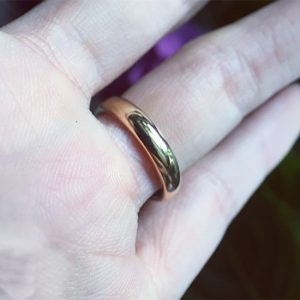When it comes to jewelry, particularly rings, an intriguing phenomenon often arises: the appearance of green streaks or discoloration on the skin, specifically around the fingers. This occurrence frequently raises eyebrows and questions alike. Many individuals wonder, “Can real gold turn your finger green?” The answer isn’t as straightforward as it may seem. While the allure of shimmering gold is unmistakable, understanding the chemical interactions that may lead to skin discoloration invites a deeper exploration.
First and foremost, it’s essential to differentiate between various types of gold. Pure gold, or 24-karat gold, is a malleable and ductile metal that is unlikely to cause any discoloration on the skin. Its chemical composition does not react adversely with human skin. However, the real charm of gold jewelry often lies in its alloyed form, comprised of metals such as copper, silver, or nickel. This is where the story begins to complicate.
When gold is alloyed, it doesn’t merely change the intrinsic value of the piece; it also alters its fundamental properties. For instance, 14-karat or 10-karat gold contains a significant percentage of other metals. While these alloys may enhance the durability and aesthetics of the jewelry, they might also result in a regrettable interaction with the skin. For individuals with sensitive skin, the copper or nickel in the alloy can lead to a chemical reaction, producing copper salts that result in green discoloration.
Moreover, environmental factors can exacerbate this reaction. Humidity, perspiration, and exposure to certain substances such as lotions or perfumes can contribute to the chemical process. When sweat meets copper, for instance, the perspiration creates an acidic environment, facilitating the oxidation of the metal. The resulting copper oxide can adhere to the skin, leaving a telltale green stain. This not only exemplifies a reaction to the jewelry itself but underscores an intricate relationship between metal, body chemistry, and environmental conditions.
But why do we care? There’s something inherently fascinating about this phenomenon. It brings to light a blend of chemistry and personal aesthetics, highlighting how our bodies interact with the materials we adorn ourselves with. Jewelry is not just a mere accessory; it often serves as an extension of our identity and self-expression. The delicate interplay between skin chemistry and metallic composition invites contemplation about the nature of beauty and the science that underpins it.
Interestingly, the reaction isn’t necessarily a reflection of the jewelry’s quality. High-quality gold pieces can and do turn fingers green, depending on their alloy composition. Conversely, some lower-quality gold may not induce such discoloration due to a different metallic mix or even superficial plating. Understanding this nuance challenges the assumption that price always correlates with skin compatibility.
Many individuals mistakenly believe that the solution to the green finger issue is simply to purchase higher karat gold. While it might be true that higher karat options, like 18K or 22K, contain more pure gold and fewer alloying agents, it does not entirely guarantee a reaction-free experience. After all, personal skin chemistry varies significantly from person to person; what causes a reaction for one may be perfectly harmless for another.
For those who lean towards the softer hues of gold, yet desire to avoid any unfortunate staining, there are strategies to mitigate this reaction. Applying a clear coat of nail polish on the inner surface of rings can create a barrier between the skin and the metal. This simple act might preserve both the integrity of the jewelry and the complexion of the skin, ensuring a harmonious coexistence.
Additionally, choosing jewelry that is specifically designed for sensitive skin can be an optimal route. Many jewelers now offer pieces made with hypoallergenic metals. These materials are less likely to cause irritation and are often blended in ways that minimize the risk of discoloration. Looking for jewelry that is clearly labeled with its composition can help when making purchasing decisions.
Furthermore, understanding the maintenance of your jewelry can help prevent issues. Regularly cleaning the pieces and properly storing them away from moisture can help in minimizing oxidation. Simple practices, such as removing rings before engaging in activities that might induce sweat, can also go a long way in prolonging the jewelry’s beauty and wearability.
Ultimately, while real gold itself is unlikely to turn your finger green, its alloyed forms certainly can. The complex interactions between metals, skin chemistry, and environmental factors reflect a fascinating intersection of beauty and science. Whether one is drawn to gold for its beauty, symbolism, or investment potential, awareness and understanding of these intricate dynamics can enhance the appreciation of the jewelry and the wearer’s experience. In the end, the journey to finding the perfect piece of jewelry is as much about personal choice as it is about the engaging dialogue between ourselves and the materials we choose to adorn ourselves with.
